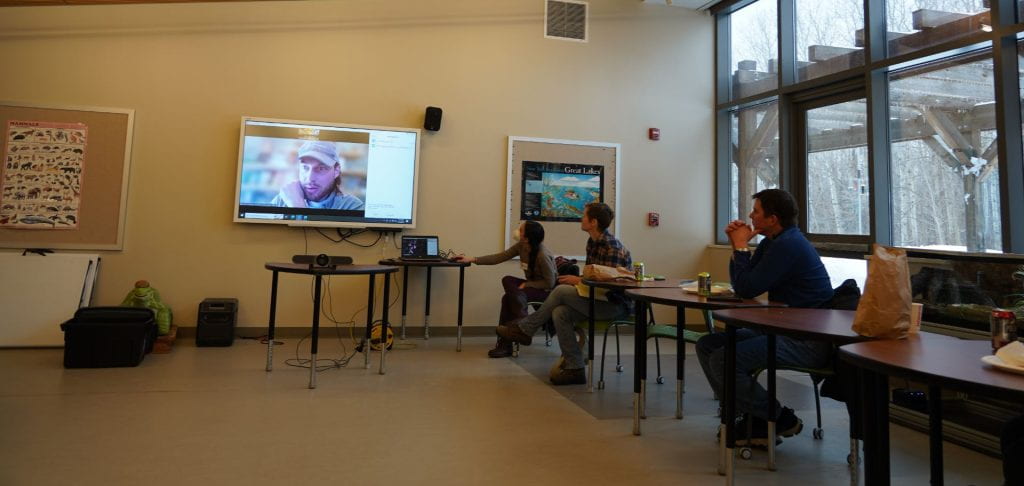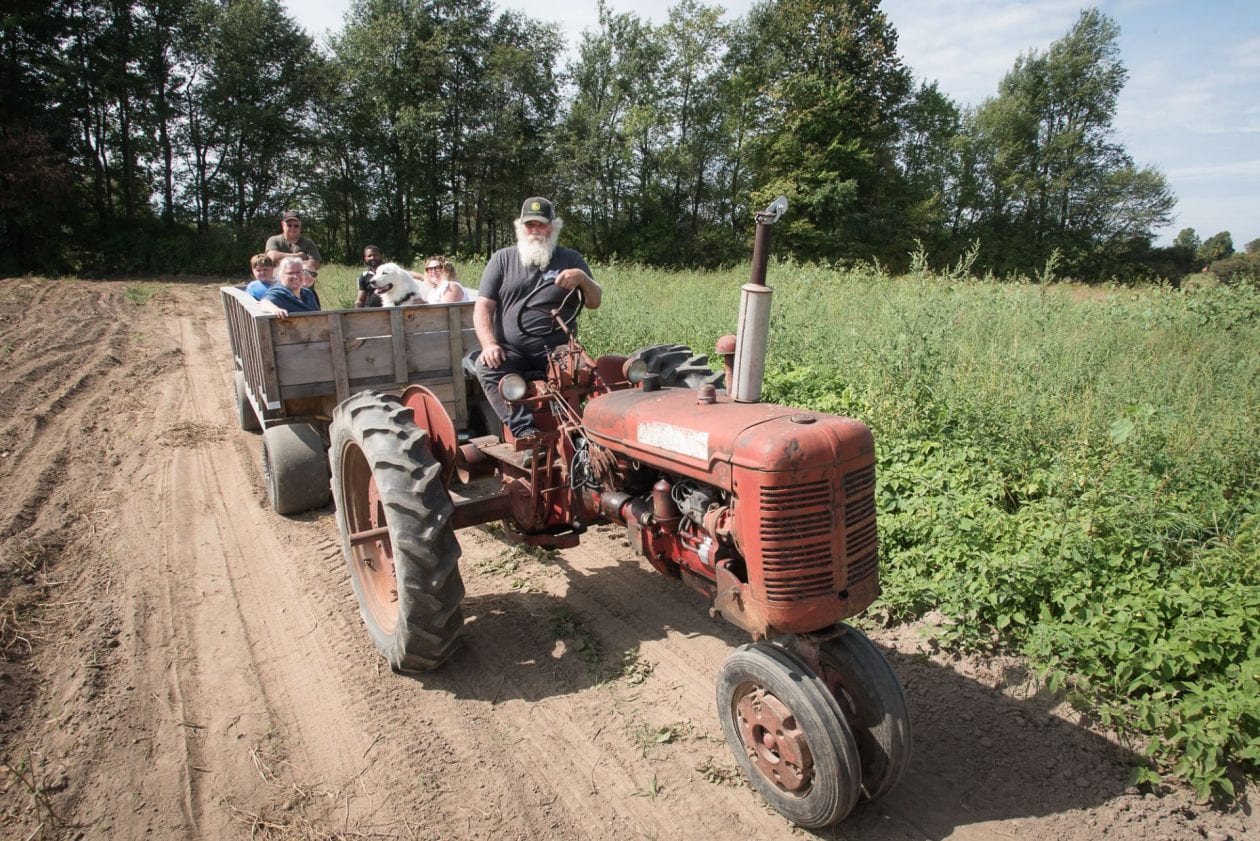The second course in the 2023 Ag and Food Producers Academy, Building an Agritourism Experience on Your Farm, concluded on February 18th, with a wonderful day of field trips after three online evening sessions.
The online sessions offered an opportunity for the 10 participating agriculture businesses to dig into the nitty gritty of creating and running an agritourism activity. Instructor Mary Godnick, Communication Coordinator for Adirondack Harvest, and guest instructor Lindsey Pashow, CCE Agriculture Business Development and Marketing Specialist, guided us through goal setting, insurance and liability considerations, and how to effectively market to your desired audience.

Our field trip time got us out into the community seeing the course materials applied by local businesses. In mid-February, we visited Kaneb Orchards in Massena, had lunch at the Nicandri Nature Centure with a special guest speaker Dillon Klepetar of Farmstead Catering at Echo Farm, and ended the day at Martins Farmstand in Potsdam.
We covered a tremendous amount of information over the past few weeks and want to share some takeaways with farm and food business owners or new entrepreneurs who’d like to create an agritourism experience, or further develop their current one. Find several great resources at the close of this post to help with your agritourism planning.
1. Determining Goals and Boundaries
Whether you’re an existing farm or are in the planning stages of your business, consider your goals, how an agritourism enterprise might help you achieve your goals, and your boundaries.
As important as it is to determine what your goals are for an agritourism venture, it’s equally important to determine what boundaries you have regarding your time, effort, and facility capacity. Essentially, what do you not want to do? In our first class, Mary discussed her experience with hosting on-farm meals because she knew it would be a popular option for consumers. But in practice, to run these experiences she was in the kitchen for long periods of time on those beautiful summer days, so she decided not to offer these anymore.
When you come up with an idea for an agritourism activity, think about what you need to do to make it happen and the boundaries that may prevent your pursuit of it. You can ask yourself how the activity fits into your available time, how much effort you’d like to put into it, and your facility capabilities. This isn’t to say you cannot do something if you do not have the current facility or time for it, you can assess how you can make it happen. You might consider hiring help or constructing a new area for it, etc. Or you can determine it’s not the right option for you and pursue a different activity.
Takeaway: Think about your boundaries for agritourism activities to create a better experience for both you and your customers. You won’t be forcing an idea or activity that does not fit well with your lifestyle or capabilities.
2. Creating a Festive Environment
Many businesses want to increase their income with agritourism, but there’s many ways to do that. At Kaneb Orchards they host music events in September and October that are free and open to the public, often with other local vendors in attendance. They decided not to charge an entry fee for their music events and find it’s worth their while to create a festive environment. Folks come to enjoy the music, and in that relaxed, welcoming environment, purchase multiple goodies from the farm store such as donuts, sweet cider and hard ciders.

Takeaway: Look at your business plan and see if there are ways you can draw people to your farm event through your own funds that will result in increased sales of your main products. You might eat the cost upfront for a few years as you build up your customer base and publicity, but these smaller investments may pay off in the long run.
3. Preparing for the Public
One of the many benefits to having people visit your property is developing loyal customers. These connections are important for business vitality and are built upon you properly preparing to receive and provide for your guests.
During our second class, Lindsay Pashow spoke about user experience and risk. She emphasized visitor expectations. Think about the flow of your experience. Do you have clear signage for parking? Do you need someone to lead guests to the event or activity? Do you have clear areas marked off where you don’t want people to go? Are there any hazards to consider? Lindsey also noted the importance of diving into the details of your agritourism experience with your insurance agent to make sure you are adequately covered. It’s a good idea to discuss your ideas and activities with a lawyer to understand and mitigate the risks of your business, too.
 You want your visitors to have a memorable and safe experience. Martins Farmstand offers u-pick strawberries and flowers where people of all ages can come and reconnect with the land. Daniel Martin discussed how he balances the many positives of welcoming people to their farm along with the negatives. You might have folks wander where you don’t want them to or need to assist someone who is upset. Martin’s aims to reduce possible risks ahead of time and then take care of visitors with hospitality. This builds trust which improves the visitor experience.
You want your visitors to have a memorable and safe experience. Martins Farmstand offers u-pick strawberries and flowers where people of all ages can come and reconnect with the land. Daniel Martin discussed how he balances the many positives of welcoming people to their farm along with the negatives. You might have folks wander where you don’t want them to or need to assist someone who is upset. Martin’s aims to reduce possible risks ahead of time and then take care of visitors with hospitality. This builds trust which improves the visitor experience.
Takeaway: Consider how you will prepare for visitors to your farm. The public can bring great rewards, along with new challenges. Balance the beauty of creating a community experience for your customers, with the business details of protecting your business from risks.
4. Reaching Your Audience
Identifying your target audience is the first step to effectively market your agritourism endeavor. Who are you trying to reach? It might be young local families, tourists, etc. Then think about where they’re most likely to get their information. Consider social media, print news, or online websites like Trip Advisor.
It’s important to remember that certain marketing methods take different levels to maintain but social media, websites, printed news and ads, local food guides, etc. are all powerful strategies to publicize your business. Utilizing a mix of different techniques can broaden the awareness of your agritourism attraction, too.
Kaneb Orchards noticed a significant increase in sales after they rented the billboard across the street from their orchard while Daniel Martin discussed the flexibility Facebook provides in the height of berry season when he can post updates multiple times a day. These time sensitive messages are easier to disperse on social media than a website.

Dillon Klepetar spoke about his website being the anchor of their online presence filled with photos that focus on the story of their unique farm-to-table wedding to engage their clients. This method allows potential clients to envision how the services of Farmstead Catering can create a wonderful experience and memories.
Takeaway: The marketing outlets that are best for your business will depend on your target audience and business needs. Think about the story you’d like to tell or how you want your customers to feel when they are on your farm or participating in your events.
5. Finding More Information
Here are a few excellent resources from Cornell and University of Vermont to help you plan an agritourism experience:
- Getting Started in Agritourism – Includes a great check-list to help you prepare for an agritourism experience.
- Best Practices for Agritourism – Incorporates everything from assessing your farm, business and financial planning, to marketing
- Agritourism Risk Management – Includes NYS and county laws on agritourism, risk identification, insurance companies
One common thread between the different field trip speakers was that they also wanted to learn from the course participants. While these written document resources are essential for success, so is speaking with other farmers about their trials and tribulations in agritourism.
Takeaway: Many free resources are at hand, but remember to reach out to your fellow business owners to connect and learn from one another.
Other winter Ag and Food Producer topics include high tunnels and commercial kitchens. Stay tuned for those course recaps!
Laurel Balog is the Food System Program Assistant within the Local Foods Team. She has a background in ecology, organic agriculture, food systems, and provides logistical and planning support for Extension’s Local Food programming.
